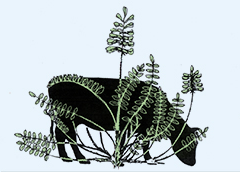Abstract
Broom snakeweed [Gutierrezia sarothrae (Pursh) Britton and Rusby] and threadleaf snakeweed [G. microcephala (DC.) A. Gray] are found on many rangelands in western North America. Snakeweeds are generally unpalatable; however, animals will graze them when other forage is not available and there are field reports that pregnant cows that graze snakeweeds may abort calves. Subsequent feeding studies using fresh cut snakeweed, ground and gavaged into pregnant cattle have failed to reproduce abortions, though it was evident that at high doses snakeweed quickly damaged the rumen microflora resulting in severe rumen atony, bloating and acidosis. We report here an attempt to solvent extract the snakeweeds, mix the extracts with ground alfalfa hay, and test the extracts for abortifacient activity in late-term pregnant cattle. The dosed extracts again appear to be unable to reproduce snakeweed induced abortions in cattle. Extracts from snakeweed chemotype 1 plant appear to be quite toxic to the rumen and caused complete rumen stasis after 2-3 days. In contrast, cattle receiving chemotype 2 extracts were able to tolerate over twice the dosage as that given for chemotype 1 extracts. We conclude that broom snakeweed plants are unlikely to be directly responsible for cattle abortions observed in cattle grazing snakeweed infested rangelands. It is more likely that cattle may be affected by rumen toxicity and/or might suffer from poor nutritional factors given the lack of quality forage that might be available on rangelands with high snakeweed infestation.
Recommended Citation
Gardner, Dale R.; Green, Benedict T.; Stegelmeier, Bryan L.; and Welch, Kevin D.
(2022)
"Broom Snakeweed Extracts Dosed to Late-Term Pregnant Cattle Do Not Cause Premature Parturition,"
Poisonous Plant Research (PPR): Vol. 5, p. 13-21.
DOI: https://doi.org/10.26077/15eb-503b
Available at:
https://digitalcommons.usu.edu/poisonousplantresearch/vol5/iss1/2

